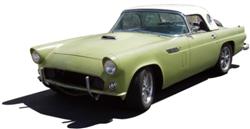My advice is to get service manual for a '56 - and read up a bit about the two stage Load-o-Matic. I got one for my T-bird when it came home (and I soon knew the antique carb and dizzy weren't for me). Too many historic problems with reliability of the teapots and Load-o-Matics - it's not that they cannot or will not work - they are just too much like owning an "English" car.
Anyway - the carb and distributor combo for the '56 Load-o-Matic constitute a system where two different vacuum signals are being used:
1.0 Engine speed is being tracked by VENTURI vacuum - the greater the air/fuel mixture speed at the carb venturi, the greater the vacuum being applied to the distributor pot. There is a port in the carb - right at the venturi restriction - causing the greatest air speed - and the "Pitot" effect is causing a proportional vacuum in that passage. That signal is fed to a distributor pot with a matching spring resistance - greater the engine speed - greater the advance.
2.0 Manifold vacuum is applied to a second pot. It creates an "offset" - an increase of a few degrees in advance when manifold vacuum is "high". The sum of the two is being used when the engine is at low/part throttle conditions. When the throttle is opened (increased engine load) the "offset" is eliminated and spark then "retards" to that governed by the venturi vacuum alone.
When people try to use the Load-o-Matic distributor with a carb that has only manifold vacuum - or ported manifold vacuum (like your Edelbrock) - it no longer has "speed sense". The modern carbs do not have a port for venturi vacuum and that part of the system cannot function as designed. You are left with the "off-set" alone and whatever initial advance has been dialed into the assembled engine. Typically - to make the engine run at all - it ends up with a really retarded arrangement.

Steve Metzger Tucson, Arizona